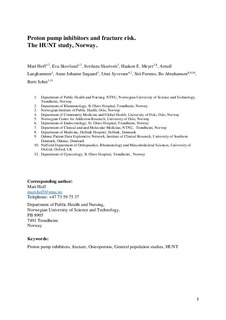Proton pump inhibitors and fracture risk. The HUNT study, Norway.
Hoff, Mari; Skovlund, Eva; Skurtveit, Svetlana; Meyer, Haakon E; Langhammer, Arnulf; Søgaard, Anne-Johanne; Syversen, Unni; Forsmo, Siri; Abrahamsen, Bo; Schei, Berit
Journal article, Peer reviewed
Accepted version

Åpne
Permanent lenke
http://hdl.handle.net/11250/2636098Utgivelsesdato
2019Metadata
Vis full innførselSamlinger
Sammendrag
Summary
Proton pump inhibitors (PPIs) have been linked to increased risk of fracture; the data have, however, been diverging. We did not find any increased risk of fractures among users of PPIs in a Norwegian population of 15,017 women and 13,241 men aged 50–85 years with detailed information about lifestyle and comorbidity.
Introduction
Proton pump inhibitors (PPIs) are widely prescribed and have been linked to increased risk of fracture.
Methods
We used data from the Nord-Trøndelag Health Study (HUNT3), The Fracture registry in Nord-Trøndelag, and the Norwegian Prescription Database, including 15,017 women and 13,241 men aged 50–85 years. The study population was followed from the date of participating in HUNT3 (2006–2008) until the date of first fracture (forearm or hip), death, or end of study (31 December 2012). The Cox proportional hazards model with time-dependent exposure to PPIs was applied, and each individual was considered as unexposed until the first prescriptions was filled. To be included, the prescription of PPIs should minimum be equivalent to 90 defined daily doses (DDD) in the period. Individuals were defined as exposed until 6 months after end of drug supply.
Results
The proportion of women and men using PPIs was 17.9% and 15.5%, respectively. During a median of 5.2 years follow-up, 266 women and 134 men had a first hip fracture and 662 women and 127 men, a first forearm fracture. The combined rate/1000 patient-years for forearm and hip fractures in women was 49.2 for users of PPIs compared with 64.1 among non-users; for men 18.6 and 19.8, respectively. The hazard ratios with 95% confidence interval for the first forearm or hip fracture among users of PPIs in the age-adjusted analysis were 0.82 (0.67–1.01) for women and 1.05 (0.72–1.52) for men. Adjusting for age, use of anti-osteoporotic drugs, and FRAX, the HR declined to 0.80 (0.65–0.98) in women and 1.00 (0.69–1.45) in men.
Conclusions
Use of PPIs was not associated with an increased risk of fractures.